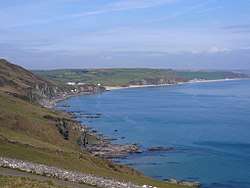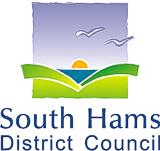South Hams
South Hams is a local government district on the south coast of Devon, England. Services divide between those provided by its own Council headquartered in Totnes, and those provided by Devon County Council headquartered in the city of Exeter.
South Hams | |
|---|---|
 | |
 | |
 South Hams shown within Devon | |
| Coordinates (Totnes): 50°25′53″N 3°41′28″W | |
| Sovereign state | United Kingdom |
| Constituent country | England |
| Region | South West England |
| Non-metropolitan county | Devon |
| Formed | 1 April 1974 |
| Government | |
| • Type | District council |
| • HQ | Totnes |
| • Sub-divisions | Civil parishes |
| • UK Parliament | South West Devon Totnes |
| • MPs (respectively) | Gary Streeter Anthony Mangnall |
| • Political party | Conservative |
| Area | |
| • Total | 342.28 sq mi (886.51 km2) |
| Area rank | Ranked 41st |
| Population (mid-2019 est.) | |
| • Total | 87,004 |
| • Rank | Ranked 280th |
| • Density | 250/sq mi (97/km2) |
| • Ethnicity | 99.09% White
|
| ONS code | 18UG |
| Website | http://www.southhams.gov.uk |
Beside Totnes are its towns of Dartmouth, Kingsbridge, Salcombe, and Ivybridge — the most populous with 11,851 residents, as at the 2011 Census.
To the north, it includes part of Dartmoor National Park, to the east borders Torbay, and to the west Plymouth. It contains some of the most unspoilt coastline on the south coast, including the promontories of Start Point and Bolt Head The entire coastline, along with the lower Avon and Dart valleys, form most of the South Devon Area of Outstanding Natural Beauty. The South Hams, along with nearby Broadsands in Paignton, is the last British refuge of the cirl bunting.
History
The South Hams were originally part of the Brythonic (Celtic) Kingdom of Dumnonia later reduced to the modern boundary at the River Tamar as Cornwall presumably during the tenth-century reign of Æthelstan. Post-Roman settlement on coastal promontory hillforts, such as Burgh Island, follows the established pattern of trading—of tin in particular—found across the western, so-called 'Celtic', Atlantic coastal regions. In the later Anglo-Saxon era, the South Hams was a feudal estate consisting of all of the land between the River Plym and River Dart and south of Dartmoor with the English Channel forming the southern boundary. There is some evidence that Cornish was spoken and understood in the area until the late Middle Ages.[1]
In 1917, the village of Hallsands was abandoned after much of it was lost to the sea. This happened because the shingle bank protecting the shore was removed to help build Devonport dockyard.[2]
In 1944 several villages were evacuated so that training for D-Day could be carried out in secret. The area was chosen because of the resemblance of its beaches to those of Normandy. Preparations were disrupted, and secrecy nearly compromised, by a devastating E-boat attack during Exercise Tiger. In 1967, the suburban towns of Plympton and Plymstock were amalgamated with the City of Plymouth.
The current district was formed on 1 April 1974, under the Local Government Act 1972, by the merger of:
- Borough of Dartmouth
- Borough of Totnes
- Kingsbridge Rural District
- Kingsbridge Urban District
- Plympton St Mary Rural District
- Salcombe Urban District
- Totnes Rural District
In the 2016 EU Referendum it voted to remain with a very high (80.3%) turnout.[3][4]
Geography
Geography divides into three unequal, fuzzy bands, one with bays, headlands, the birdlife, fishing and small harbour towns' estuaries and rias; an unequal wide-ranging elevations middle band with the main, well-conserved towns and; a sparsely populated, upland National Park moorland in the north. For over a century its tourism was concentrated around the railway, with most stations built here from 1847–1872 so tourism to its beaches and fishing villages began in earnest much later than to the 'English Riviera' east of the area. South Hams' widespread tourism multiplied on the dualling of the A38 and time-cutting construction of the M5 and A303 across other parts of south-west England.
In the north, there is...the "wildscape"—...[a new] bypass [to the A30, the A38]...cut[s] through some of the most beautiful country in Britain, that of the Dartmoor national park....while in the south-west there is extensive mining of china clay...[an abortive] tungsten mine in the Shaugh Prior — Sparkwell area will be [would have been] amongst the largest in the world and probably the largest in Europe. The wildscape band runs from Cadover Bridge and Shaugh Prior in the west right over to the other side of Dartmoor, to the Avon dam, Shipley Bridge and South Brent, touching the outskirts of Buckfastleigh.
The second band is the agricultural belt of lush, fertile farmland which produces some of the finest milk and Devon cream. Within that belt are the medieval towns of Modbury and Totnes and small hamlets and villages such as...Holbeton, Marldon and Berry Pomeroy, which would no doubt produce very fine wine if it were French. There are fruit farms and vineyards and the land flows with milk and honey.
The third band is the Heritage coast [and South Devon Area of Outstanding Natural Beauty], running from near the fishing port of Brixham through Churston, Kingswear, Dartmouth, Slapton Sands, Torcross, East Prawle, Salcombe and Bigbury Bay almost to the boundaries of Plymouth in Heybrook bay. That area is filled with rivers such as the Erme, the Plym, the Avon and the Dart. [There is] an island in the shape of Burgh Island. There are rolling hills, deep wooded valleys, estuaries full of fish and a coastline full of crab, lobsters and oysters. The climate is warm and mellow. Some regard it as a garden of Eden. We even have a naturist beach and hotel. ...forgive me if I wax lyrical about this beautiful, delightful area. Tourism is an important livelihood...the other is farming...for many.[5]
— Anthony Steen, MP for this area (1983–2010), South-West Region potential and current public priorities debate, 1983)
Note: The aforementioned Brixham and Churston are in neighbouring Torbay, rather than South Hams.
Settlements
- Ash, Aish, Allaleigh, Ashprington, Aveton Gifford
- Badworthy, Bantham, Beesands, Beeson, Berry Pomeroy, Bickleigh, Bigbury-on-Sea, Bittaford, Blackawton, Blackpool, Bolberry, Brixton, Broadhempston, Buckland-Tout-Saints
- Charleton, Chillington, Chivelstone, Churchstow, Cornwood, Cornworthy, Curtisknowle
- Dartington, Dartmouth, Dean Prior, Didworthy, Diptford, Dittisham, Dodbrooke (neighbourhood of Kingsbridge)
- East Allington, East Charleton, East Portlemouth, East Prawle, Ermington
- Ford, Frogmore
- Goveton
- Hallsands, Halwell, Harberton, Harford, Hemsford, Heybrook Bay, Holbeton, Holne, Hutcherleigh
- Ivybridge
- Kingsbridge, Kingston, Kingswear
- Landscove, Ledstone, Lee Moor, Littlehempston, Loddiswell, Lutton
- Malborough, Marldon, Michelcombe, Modbury, Moreleigh
- Newton Ferrers, Noss Mayo, North Huish
- Rattery, Revelstoke, Rew, Ringmore, Roborough
- Salcombe, Scorriton, Shaugh Prior, Sherford (near Kingsbridge), Sherford (new town), Slapton, Soar, South Brent, South Huish, South Milton, South Pool, Sparkwell, Start, Staverton, Stoke Fleming, Stoke Gabriel, Stokenham, Sutton
- Thurlestone, Torcross, Totnes, Tuckenhay, The Mounts
- Ugborough, Uphempston
- Washbourne, Wembury, West Alvington, Woodleigh, Woolston Green, Wotter, Wrangaton
- Yealmpton
References
- "When was Cornish spoken in Devon". BBC H2G2 Conversation Forum. 18 July 2010. Retrieved 6 May 2011.
- "Recalling the disaster at Hallsands". BBC Devon: History features. 1 July 2005. Retrieved 6 May 2011.
- http://old.southhams.gov.uk/eureferendumresults
- http://www.dartmouth-today.co.uk/article.cfm?id=104052&headline=South%20Hams%20votes%20to%20Remain,%20but%20UK%20as%20a%20whole%20votes%20Leave§ionIs=news&searchyear=2016
- "LOCAL GOVERNMENT BILL". Parliamentary Debates (Hansard). House of Commons. 19 December 1983. col. 278–291.
| Wikimedia Commons has media related to South Hams. |